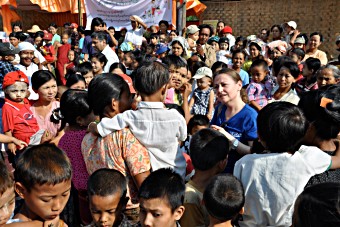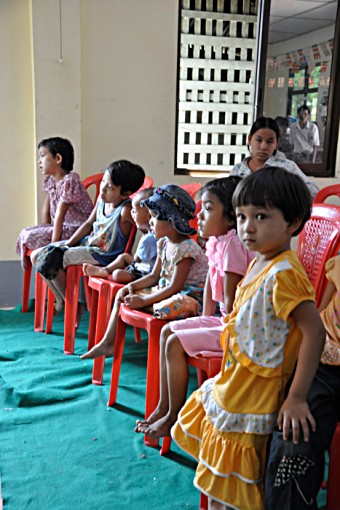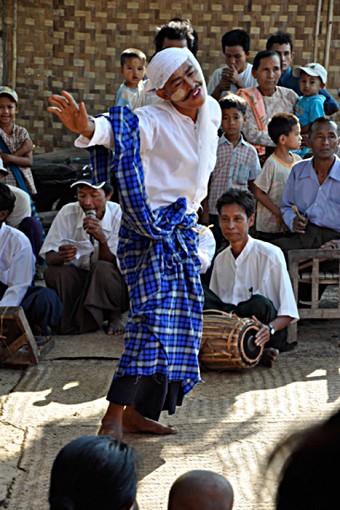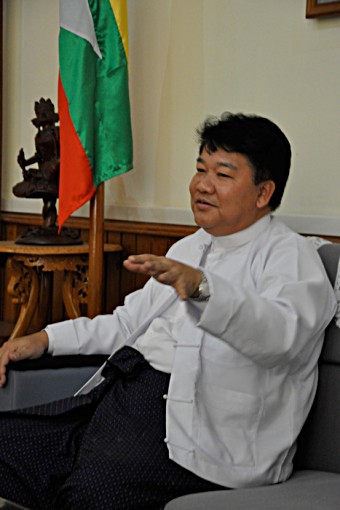
In March, Nilgun was invited to Myanmar’s new capital Nay Pyi Taw to help the Health Ministry monitor the success of a nationwide measles campaign. Photo credit: Chris Endean/GAVI/2012
Day 1
Vaccination days are a cause for celebration in Myanmar – and the Buddhist temple in Pyinmana township, near the capital Nay Pyi Taw, is no exception.
The head monk U Mya Twin is allowing nurses to use his monastery to administer measles vaccine. I remove my shoes to enter the temple, whose silence is broke by crying babies and children. However, like the golden Buddha statue watching over the makeshift clinic, I am a dispassionate observer.
To assess immunisation campaigns, you look beyond tears and smiles. Even the technique used matters; the jab should be administered to subcutaneous tissue - the third and deepest layer of skin - and parallel to the muscle so its less painful.

I’m struck that each family has been issued with an invitation card. A midwife will track down missing children to ensure everyone gets the measles jab. After injection, each card is wrapped round the empty vial so problems can be traced to the vaccine.
I observe rows of chairs for children to rest after their jab – a precaution in case of adverse effects.
A nurse uses a flipchart to explain maternal child health care. Another plus for the measles campaign: using rare contact time with families to provide vital health services.
Day 2
To avoid 40°C heat, we leave before sunrise for a mobile immunisation clinic in Ali Boke, -- a chance to see if the measles campaign reaches remote villages.
Our 4x4 bumps along a dusty embankment, rice paddies extending to the horizon on one side, a canal flowing on the other. There is no sign life here has changed since the colonial canal was built.
Thatched bamboo huts rise on stilts from the flat greens and browns of the landscape, beyond the reach of monsoon floods and lethal cobras. Oxen plough fields and farmers, bamboo hats protecting them from the sun, break their backs to earn a pittance.

At Ali Boke, there is no running water or mains electricity. A generator powers loudspeakers blaring the theme tune for the national measles campaign. Beneath banners waving in the warm wind, families register for their jabs. Someone dances for the children; it feels like a festival.
I am impressed with the turnout. By mid-morning, 200 children of the targeted 300 have received injections, but it’s puzzling families have not brought immunisation card. Nurses can’t check if children are missing other vaccines. There’s also nowhere for nurses to dispose of the used syringes and other waste.
Day 3
Vaccines perish if exposed to Myanmar’s baking heat, so I’m inspecting freezers storing vials at Pyinmana hospital. Cold mist rises as Myint Han opens a lid to reveal boxes of measles vaccines ready for distribution, usually in a cold box on the back of a motorbike.
Everything conforms to best practice, but I‘m concerned there is no emergency generator if one of Myanmar’s frequent power cuts strikes.
Limited storage means vaccines are only available on routine immunisation days, usually in the first week of each month. This works well for campaigns that occur over a few days. But there are not enough vaccines stored in local hospitals to provide day-to-day routine services and run immunisation clinics in remote villages.

This will be a problem when Myanmar introduces the sophisticated pentavalent vaccine later this year. There is also no capacity or policy to take back vaccines that go unused; they risk perishing in the heat.
Day 4
Driving to the Health Ministry along Nay Pyi Taw’s deserted eight-lane highways is surreal. Built from scrubland amid rice paddies, halfway along the road from Yangon to Mandalay, Myanmar’s new capital is a work in progress.
Like most Government offices, the Health Ministry was relocated here from Yangon in 2006 when the ‘seat of kings’ was unveiled to the world.
I congratulate Minister Professor Dr. Pe Thet Khi on a successful measles campaign. Its extraordinary reach to even the remotest villages in southeast Asia’s second largest country is astonishing.
I also express concerns about shortcomings in the cold chain system that threaten Myanmar’s rollout of pentavalent vaccine.
Dr. Pe Thet Khi agrees to work with UNICEF and the World Health Organization to increase cold chain capacity. He confirms the Finance Ministry will co-finance Myanmar’s pentavalent purchase – a real breakthrough.
Returning to my hotel, I glance up at Nay Pyi Taw’s 302 foot tall golden Pagoda and reflect on the giant steps that one of the world’s poorest countries is making toward to a self-sufficient health system, independent of overseas aid.
Name: Nilgun Aydogan Title: Programme Officer, GAVI Alliance Qualification: School of Public Health, Boston University, United States Experience: Kazakhstan, Kyrgyzstan, Uzbekistan, Azerbaijan, Pakistan, Nigeria, north Africa, Middle East Objective: ensure public health systems don’t just help young children to survive but also to lead long and healthy lives. |
